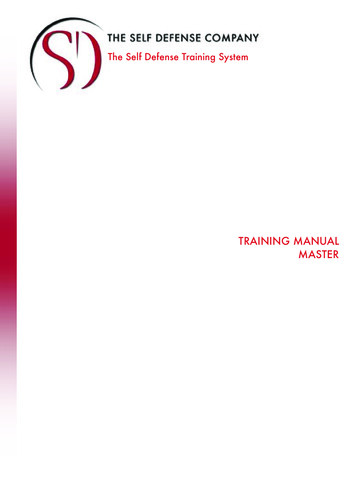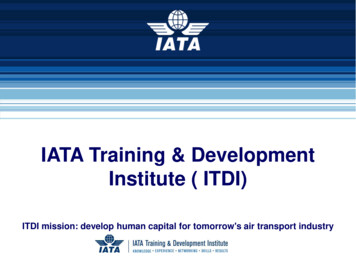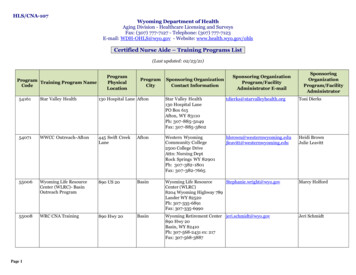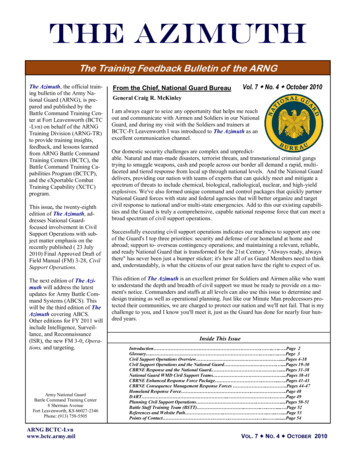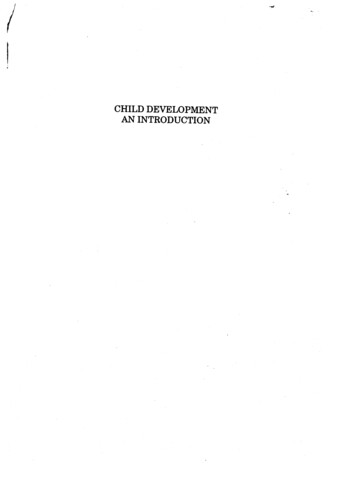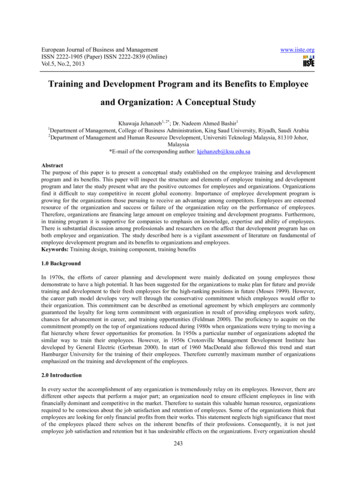
Transcription
European Journal of Business and ManagementISSN 2222-1905 (Paper) ISSN 2222-2839 (Online)Vol.5, No.2, 2013www.iiste.orgTraining and Development Program and its Benefits to Employeeand Organization: A Conceptual StudyKhawaja Jehanzeb1, 2*; Dr. Nadeem Ahmed Bashir1Department of Management, College of Business Administration, King Saud University, Riyadh, Saudi Arabia2Department of Management and Human Resource Development, Universiti Teknologi Malaysia, 81310 Johor,Malaysia*E-mail of the corresponding author: kjehanzeb@ksu.edu.sa1AbstractThe purpose of this paper is to present a conceptual study established on the employee training and developmentprogram and its benefits. This paper will inspect the structure and elements of employee training and developmentprogram and later the study present what are the positive outcomes for employees and organizations. Organizationsfind it difficult to stay competitive in recent global economy. Importance of employee development program isgrowing for the organizations those pursuing to receive an advantage among competitors. Employees are esteemedresource of the organization and success or failure of the organization relay on the performance of employees.Therefore, organizations are financing large amount on employee training and development programs. Furthermore,in training program it is supportive for companies to emphasis on knowledge, expertise and ability of employees.There is substantial discussion among professionals and researchers on the affect that development program has onboth employee and organization. The study described here is a vigilant assessment of literature on fundamental ofemployee development program and its benefits to organizations and employees.Keywords: Training design, training component, training benefits1.0 BackgroundIn 1970s, the efforts of career planning and development were mainly dedicated on young employees thosedemonstrate to have a high potential. It has been suggested for the organizations to make plan for future and providetraining and development to their fresh employees for the high-ranking positions in future (Moses 1999). However,the career path model develops very well through the conservative commitment which employees would offer totheir organization. This commitment can be described as emotional agreement by which employers are commonlyguaranteed the loyalty for long term commitment with organization in result of providing employees work safety,chances for advancement in career, and training opportunities (Feldman 2000). The proficiency to acquire on thecommitment promptly on the top of organizations reduced during 1980s when organizations were trying to moving aflat hierarchy where fewer opportunities for promotion. In 1950s a particular number of organizations adopted thesimilar way to train their employees. However, in 1950s Crotonville Management Development Institute hasdeveloped by General Electric (Gerbman 2000). In start of 1960 MacDonald also followed this trend and startHamburger University for the training of their employees. Therefore currently maximum number of organizationsemphasized on the training and development of the employees.2.0 IntroductionIn every sector the accomplishment of any organization is tremendously relay on its employees. However, there aredifferent other aspects that perform a major part; an organization need to ensure efficient employees in line withfinancially dominant and competitive in the market. Therefore to sustain this valuable human resource, organizationsrequired to be conscious about the job satisfaction and retention of employees. Some of the organizations think thatemployees are looking for only financial profits from their works. This statement neglects high significance that mostof the employees placed there selves on the inherent benefits of their professions. Consequently, it is not justemployee job satisfaction and retention but it has undesirable effects on the organizations. Every organization should243
European Journal of Business and ManagementISSN 2222-1905 (Paper) ISSN 2222-2839 (Online)Vol.5, No.2, 2013www.iiste.orghave the employees, who are capable to swiftly adjust in continuously fluctuating business environment. Today mostof the companies are investing a lot of money on the training and development of employees in order to remaincompetitive and successful part of the organization. The importance of training for employees is rapidly growing andorganizations are using this tool to compete with their competitors in the market.There is momentous discussion between scholars and professionals that training and development program haseffective impact on objectives of employee and organizations. Some of the scholars suggest that trainingopportunities increase in high employee turnover whereas the other claimed that training is an instrument which isbeneficial for employee retention (Colarelli and Montei 1996; Becker 1993). Irrespective of all discussion, most ofwriters agree that employee training is a complicated human resource practice that can expressively influence on theaccomplishment of the organizations. Furthermore, organizations are struggling to get success in the worldwideeconomy, trying to differentiate on the basis of abilities, information, and enthusiasm of their workforce. Referenceto a current report prepared by American Society for Training and Development, organizations are spending morethan 126 billion yearly on employee training and development (Paradise 2007). Training is an organized method oflearning and development which expand the efficiency of individual, group, and the organization (Goldstein andFord 2002). Development mentions the accomplishments leading to gaining of new abilities and skills for personalgrowth of employees. Furthermore, it is usually challenging to determine whether a precise exploration study reportsto training, development, or both. In the rest of all this assessment, we used the term “training” to mention trainingand development.3.0 Literature Review3.1 Training and Development ProgramInternationally different companies provides training and development program to their employees for theimprovement of their skills and abilities. In the start of 90s Sears Credit initiated a key rearrangement and retortedwith a career-development programs. This program was developed for employee in order to line up their skills withchanging jobs and also ensured that program was adding value for the growth of their organization. Companies alsothink that they were not allocating career opportunities to their employees with acquaintances and abilities to getbenefit from these opportunities (O’Herron and Simonsen 1995). JC Penny, countrywide wholesale departmentalstore, developed a virtual university to support the employees to get abilities and skills as required by their jobs(Garger 1999). Tires Plus, tire retailer based on Minnesota, established Tires Plus University to its employees toincrease recruitment, retain employees of the store, and fill up the key positions and augments whole improvement ofthe employees. U.S. Tsubaki, Illinois, established UST University to provide and calculate training andorganizational development programs that fulfill the organizational and individual needs of the organizations(Callahan 2000). All over the world different companies are providing different programs for the betterment and skillimprovement of their employees which are based on same logic.Mel Kleiman (2000) described that the essentials parts of a worthy employee training program are constructed onorientation, management skills, and operational skills of employees. These theories are the groundwork of anyemployee development program. Janet Kottke (1999) described that employee development programs must becomprises with core proficiencies, appropriate structure through which organizations develop their businesses atcorporate level. The basic function of the theory is to gain knowledge, cooperation, inventive thinking and resolvingproblem (Kottke 1999). Fundamental goals of several employee development programs are to deliver the mission ofthe organization and support workers to learn the culture of the organization (Gerbman 2000). These objectivesprovide help to the strategic goals of business by facilitating learning chances and support organizational culture(Kottke 1999). The requirements for technical training program for employees raised their job satisfaction and helpto understand the culture of organization, which lead to the success of the organization. We must take care aboutthese elements that employee should be updated with the present knowledge of the job. Employee will be moreproductive, if companies provide them training as per the requirement of the job.244
European Journal of Business and ManagementISSN 2222-1905 (Paper) ISSN 2222-2839 (Online)Vol.5, No.2, 2013www.iiste.orgToday most of the organizations have built up different programs for the training and development of theiremployees. Usually companies offered tuition reimbursement package to their employees so that they can improvetheir knowledge and education. It has been found by the Corporate University that almost 10 percent of employeesare entitled for this benefit (Rosenwald 2000). Furthermore, only senior management and those employees who areat top level are entitled for tuition reimbursement (Rosenwald 2000). As a result thereof, many organizations conductin-house training programs for their employees that are more beneficial and cheap. Training section of theorganizations attempts to concentrate on particular job proficiency whereas the corporate department is proactivewith an additional strategic approach. Training and development program is a planned education component andwith exceptional method for sharing the culture of the organization, which moves from one job skills to understandthe workplace skill, developing leadership, innovative thinking and problem resolving (Meister, 1998). Employeedevelopment programs includes a variety of teaching technique, schedule, and helping learning environment thatensure employee to improve their skills and later apply on their jobs (Gerbamn 2000).3.2 Components of Training and Development ProgramThere is no particular method for developing the employee training, however particular significant methods thatwould be measured. A perfect employee training and development program must be the mixture of knowledge,career development and goal setting. These approaches will benefit the program to be more useful for the employeesand organization. Today organizations are extensively using the Information Technology systems for their learningprograms. Knowledge and information systems are rapidly moving ahead and those companies cannot survive thatprovide up to date knowledge of I.T. to their employees. For a new task training must be given to employees so thatthey can easily cope with new task. It should be the responsibility of the organization to assured that employees haveknowledge, skills and abilities, and these skills must be according to the required level of the job. Furthermore, whenemployees need required skills and knowledge it should be provide them on the right time without any delay. In theresult thereof, companies required to make sure that employee can learn whenever they required (Garger 1999). Tocomplete this purpose organizations required the internet and computer based learning segments.The basic reason for career planning as quantity of employee training program is not merely to support employees tothink that their employers are financing in their career, furthermore keep in mind that they help employees to managevarious characteristics of their lives and a clear promotion track. Employers cannot make promise with employeesfor their job security, but they provide them opportunities to improve their knowledge and skills, so that they canremain sustain in job market (Moses 1999). Career development of the employees should be established on brightcareer path which employee can easily recognize and gave it worth (Nunn 2000). To achieve this purpose, employeemust classify their work, work priorities and current skills they have to do their job. Therefore, employees can startidentify the jobs that would require in future and set of skills to manage those jobs (Moses 2000). As result thereof,employee should improve understanding to work, better accountability for career and strategy for action to attainupcoming goals.The main problem suffer by organizations is to commit this practice, which may take some employees to leave theorganization and look around for certain job vacancies outside the organization (O’Herron and Simonsen 1995).Furthermore, sometimes employees feel the risk of right sized of employee in the organization. The key element ofcareer planning and employee development is goal setting. Therefore it has been described that learning programssupport employees to enhance their performance instead of just increasing their work competencies (Gerbman 2000).It is better to give the opportunity to employees to perform their jobs in a better way and if they need help,organizations must provide them proper tools to perform the job. Development program help the employees to learnand facilitating them to become a critical philosopher (Garger 1999). Sears Roebuck & Co. remains careful on thisidea as organization doesn’t want that all employees think similar but the organizations need to give those employeesconceptual skills to think in a different way (Gerbman 2000).An employee from Tires Plus described that he educated additional about the organization instead of just doing hiswork and this assist him to think in what way he can positively influence on the goals of the organizational (Dobbs,2000). Individual should improve their knowledge so that organizations get them hand to hand and pay them good245
European Journal of Business and ManagementISSN 2222-1905 (Paper) ISSN 2222-2839 (Online)Vol.5, No.2, 2013www.iiste.orgsalary. It is the main responsibility of the organizations to provide opportunities to their employees but individualshould take initiative to use those opportunities for the betterment of their future career (Garger 1999). Employeetraining and development programs should create in a way that it not only accomplish its goals but have optimisticconsequences on employee and organization. The organizations which are using employee development programsare getting positive results from the individuals by using this program.3.3 Individual Benefits from Training and Development Program3.3.1 Career CompetenciesEmployees get a lot of benefits from the employee training and development program. They learn the soft andtechnical skills as required by their jobs. In last 30 years unemployment is at its lowest rates which is not beneficialfor the workers to start new job, if opportunities for growth are fewer (Dobbs 2000). Fresh university graduatesmostly considering for a firm which provides intensively training programs to their employees, but this idea is riskyfor organizations to lose fresh trained employees with couple of years (Feldman 2000). Professional which are placedin the industry of information technology, identify that knowledge is authority and they required to retain theirabilities and talent according to current requirement of the market. Most of the employees recognize the importanceof training program and would like to increase their salary (Dillich 2000). It is also expected from the fresh graduatenot appropriately equipped for the continually changing business environment (Gerbman 2000). Young professionalswith entrepreneurial ambitions know that they have shortage of experience and money; hence they attempt to joincompanies which provide training programs to prepare their employees for the betterment of future (Feldman 2000).Employee development program help employees to survive in the future and develop their abilities to cope with newtechnologies.From many years the requirements for blue-collar jobs is constant, and numerous companies have prepared amodification for demanding learning software and programmed systems (Cunniff 2000). This requirement iscompelling workers to appraise their profession capabilities to sustain their employment. Due to this situationnumerous employees have rehabilitated their attitude to acquire promoted inside their organizations to work anddevelop out of the organization (Feldman 2000). Therefore workers used to prepare 10 year plan for their future andconstantly change their plans after two years as per the change of technology and information (Wilson 2000). TiresPlus delivers training to promote a diverse career through the organization which comprises 80 hours training forsupervisor to promote them to the manager (Dobbs 2000). I-Cube, Information technology consulting firm inMassachusetts, provide employee development program for their employees which is named by I-Altitude and offerto fresh employees so that the can easily adjust themselves in the organization (Fenn 1999). Employees understandthat training program can directed to superior duties and higher remuneration (Fenn 1999). Furthermore, helpingworkers to improve their skills and knowledge to cope with the future requirements, lead to job satisfaction.3.3.2 Employee SatisfactionEmployees have no feeling about their organizations, if they think that their organizations are not caring about them(Garger 1999). Companies which are willing to spend money on their employees, give value to work with thosecompanies, even though that investment eventually benefits the organization (Wilson 2000). Companies which areproviding the training and development programs for their employees are achieving high level of employeesatisfaction and low employee turnover (Wagner 2000). Training increase organization’s reliability for the reasonthat employees recognize their organization is spending in their future career (Rosenwald 2000).Loyalty with the organization cannot be calculated but it is substantial to intrinsic reward that employee feel.Employee feels comfortable and wants to stay with their organization, when they feel they are putting their effortsand skills in the bottom line for their organization (Logan 2000). Employees who are satisfied with their jobs, believethat their work has a purpose and important for their organization (Moses 2000). Usually the best performers do notleave a job for the purpose of financial benefits. Though salary and benefits plays an important part in selecting andretention of the employees, employees are always observing the opportunities to acquire novel skills, to get the246
European Journal of Business and ManagementISSN 2222-1905 (Paper) ISSN 2222-2839 (Online)Vol.5, No.2, 2013www.iiste.orgencounter of different duties, and looking for personal and professional development (Wagner 2000). Therefore,nourishing these requirements facilitates in figure up confidence, self-esteem and job gratification in employees(Nunn, 2000).3.3.3 Employee PerformanceTraining effects on behavior of employees and their working skills which resulted in enhanced employeeperformance and further constructive changes (Satterfield and Hughes 2007) that serves as increase employeeperformance (Kraiger 2002). Arthur et al. (2003) developed an analysis of 1152 sample size from 165 resources andrevealed that in distinction with no-training or pre-training conditions; training had commonly positive result onjob-related performance. However, dissimilarities in positions of effect sizes were not big, the efficiency of trainingvary regarding the training transfer technique and the skill being trained. Benefits of training program are also relatedto technical skills of the employees. For instance, Davis and Yi (2004) developed two researches with approximately300 contributors with the help of behavior-model training and remained capable to increase significantly computerskills. Psychologically practicing tasks permitted trainees to grow learned knowledge, abilities and task.Training is positively effects on the employee performance of the employees. During a qualitative study concerningmechanics in India, Barber (2004) originates that on-the-job training headed to superior novelty and implicit skills.Technical and professional skills are very important for the employees to perform a job in an effective way.Providing training opportunities to employees can enhance the performance of the employees. Reference toinvention, training increased the educated mechanics to figure up two Jeep bodies using only a homemade hammer,chisel, and oxyacetylene welder. Concerning to implicit skills, Barber described in his study that profession of amechanic needs “feel” to remain successful. Barber (2004) described in the result of an effective training that amechanic had worthy emotion of how to hit the metal at the particular spot so that work must be performed in asystematic and proper way.3.4 Organizational Benefits from Training and Development Program3.4.1 Market GrowthEmployee development programs are important for any organization to stay solvent and competitive in the market.Though it is expensive for the organization to spend the money on their employees but this investment is positive forthe organizations to hold the place in the market. American Society for Training and Development mentioned twomotives that are significant for employee’s knowledge, first employees identify the worth of training and marketableby organization and second CEOs of the companies understand that how fast information is transferring in currentbusiness environment (Fenn, 2000). Greengard (2000) described that organizations are required to develop andmaintain such learning environment for the employees that expand the knowledge of organization and competitiveability. However, employee training programs derived through a high price, but have a positive impact onreturn-on-investment. Microsoft, and General Electric Company are entirely large effective organizations, and theseorganizations realize training opportunities as an investment (Kleiman 2000).Wanger (2000) described in his study that American Society for Training and Development found an associationbetween financing in employee development program and higher revenues from stock market. American Society forTraining and Development moreover originate that companies who apply average of 1,575 each employee onlearning got 24 percent growth in gross profit and 218 percentage increase in revenue each employee instead of thosewho spend fewer on employee training and development, investing in employee development is a condition that issuitable for individual and organizations (Rosenwald 2000). Furthermore, employee training and developmentprograms not only increase the profit of organizations but also provide difference within their native market.Organizations can practice training and development opportunities to support them available to the currentemployees, perspective employees, plus clients of the company. GSD&M’s Idea U, assists employees to recognizetheir characters and established that it has prepared people as superior contributors to business (Petrecca 2000).247
European Journal of Business and ManagementISSN 2222-1905 (Paper) ISSN 2222-2839 (Online)Vol.5, No.2, 2013www.iiste.orgLastly, organizations can utilize employee training and development programs to improve their appearance as bestemployer in the job market.3.4.2 Organizational PerformanceTraining has been defined as mainly contributing factor to the organizational effectiveness (Schuler and MacMillan1984). Exploration on this topic recommends that investment in training and development program can be justifiedby the impact it creates to developed individual and organizational effectiveness (Bartel, 2000). Furthermore, theearlier researches have mentioned causation between training and effectiveness of the organization (Blundell,Dearden, Meghir and Sianesi, 1999). Bartlett (2001) recommends that one of the glitches that is usually problematicto identify, is proposing an effective calculation of performance of the organization. Blundell et al. (1999) supportedthis by describing that lack of suitable data and methodological difficulties prevents the adequate assessment ofimpact of human capital appreciation and performance of organization. However, there is an increasing factor thatHuman resource management practices impacts on attitudes and work-related manners (Allen et al., 2003). Toevaluate the effectiveness of training and development program it has been advised that check directly therelationship of training and organizational commitment. Further it has been revealed as certainly correlated to theefficiency of the organization (Bartlett 2001).The study proposes that constructive work-related performance and attitudes mainly depend on the perception of theemployees as the employees think that their organizations are taking care of them (Allen et al., 2003). However, thesame factor is reliable with the social exchange model; Blau (1964) suggested that the emotional agreement betweenemployer and employee are the central element of organizational performance. Gould-Williams (2007) proposed thatsocial exchange theory was originated by the organizations when they decided to care the interest of their employees.Employees respond with optimistic attitudinal and behavioral replies which are supportive to their organization(Settoon, Bennett and Liden 1996). However training can be used to provoke the preferred results that may containwith enhanced organizational commitment (Bartlett 2001). The current research proposed that the facility of trainingand development program is likely taken consent by employee that their organizations need to enter a socialexchange with them. This social exchange agreement produces a durable psychological bond between employee andorganization (Garrow 2004).3.4.3 Employee RetentionThe research described that employee retention is a challenging notion and there is no particular method to retainemployees with the organization. Several organizations have revealed that one of the characteristic that help to retainemployee is to offer them opportunities for improving their learning (Logan 2000). Therefore, it has confirmed thatthere is strong relationship between employee training and development, and employee retention (Rosenwald 2000).Companies should realize that experienced employees are important assets and companies have to suffer thechallenge for retaining them (Garger 1999). Therefore, companies which are providing training and developmentprograms to their employees are getting success in retaining them. Sears has established that in localities wheremanager provide help to their employees to develop professionally, turnover is almost 40-50 percentage fewer thanthose stores where association with the managers does not available (Logan 2000). On other side, numerousemployees participate in employee training programs are not assured of a conventional association betweenprograms and employee retention (Rosenwald 2000); several managers found that positive learning atmospheredirected to higher retention rates (Dillich 2000).Organizations that are offering employee development programs are getting success with retaining employees. Aneffective design of training program can also increase retention among employees. Employee retention is a volunteermove by organizations to create an environment which involves employees for long term (Chaminade 2007). For thedescription of more effective retention, researchers have recommended that organizations may contain with trainingand development program that classifies volunteer assignments, requirements, and expectations (Seigel and DeLizia1994). “To retain employees, organizations need to think seriously about their investment in training anddevelopment” (Leonard, 1998). Fenn (1999) presented in his study that the normal monthly turnover at Unitel has248
European Journal of Business and ManagementISSN 2222-1905 (Paper) ISSN 2222-2839 (Online)Vol.5, No.2, 2013www.iiste.orgdecreased from 12 percent to 6 percent since they inaugurated Unitel University in 1998. Though numerous personsinvolved with employee training and development programs are not assured of a direct association between theprograms and employee retention (Rosenwald 2000). However, specific numbers of managers discover that aconstructive learning environment pointed to higher retention rates (Dillich 2000).4.0 ResultsThe facts in current research can be utilized in numerous diverse ways by a diversity of organizations. Thesignificant opinion is that companies essentially put the highest worth on their employees, and develop beliefs andpractices that show the highest commitment of the employees. Employees required feeling like they are producing anoteworthy modification to corporate success and providing positive results and intentions to do their jobs well.Furthermore, it is difficult for most of the companies to develop corporate level institutions and provide extensiveopportunities for internal promotions, but it is easy for organizations to help their employees in making career goalsand action plans for the development of their career. Certain organizations may discover that they develop employeeswho apply their abilities and skills for further organizations; however the organizations also find that they areincreasing a sense of loyalty from other employees. In this study there is a substantial support for individuals andorganization to get the several benefits from training program. Such benefits contain efficiency and factors thatrelated directly or indirectly to the employee performance. This study has collected support for the positive outcomesof training program for the organizations. These benefits
2Department of Management and Human Resource Development, Universiti Teknologi Malaysia, 81310 Johor, Malaysia *E-mail of the corresponding author: kjehanzeb@ksu.edu.sa Abstract The purpose of this paper is to present a conceptual study established

